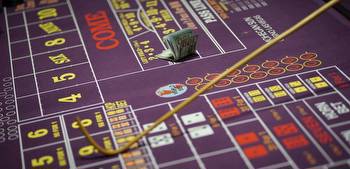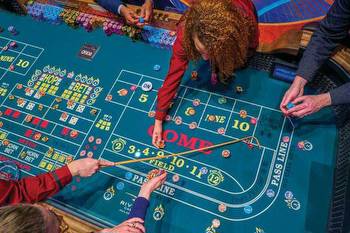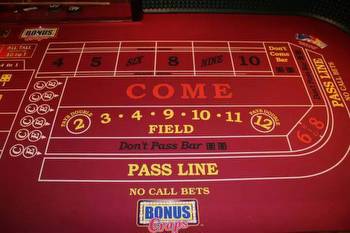The Ultimate Guide to Craps Table: Everything You Need to Know

Table of Contents
A craps table is a fundamental component of the popular dice game known as craps. It serves as the central platform where players place their bets and the game unfolds. Whether you’re a seasoned player or new to craps, understanding the table layout, bets, and rules is essential to enjoying this exciting casino game.
Key Takeaway
A craps table is a specialized gaming surface where players gather to bet on the outcome of dice rolls. It consists of various sections for different betting options, and learning the table layout is crucial for effectively participating in craps.
What is a Craps Table?
A craps table is specifically designed for playing the dice game known as craps. It typically measures around 12 to 14 feet long and contains multiple betting areas. The table is manned by casino dealers who oversee the game and handle payouts.
At first glance, the craps table may seem intimidating due to its many sections and markings. However, once you understand its layout and how the game works, it becomes more accessible and exciting to play.
How to Play Craps
Playing craps involves rolling a pair of dice on the craps table and betting on the outcome. The game begins with a “come-out” roll, where the shooter (the player rolling the dice) aims to establish a point number (4, 5, 6, 8, 9, or 10). If they roll a 7 or 11, it’s considered a “natural” and a winning roll.
If the shooter rolls a 2, 3, or 12, it’s called “craps,” resulting in a loss for some bet types. Once a point number is established, the shooter continues rolling until they either hit the point again or roll a 7, which ends their turn. Players can place various bets on each roll, and the game progresses accordingly.
Types of Craps Bets
There are numerous types of bets players can place at a craps table, each offering different odds and payouts. Here are some common bets:
Pass Line Bet
The Pass Line bet is the most basic and popular craps bet. Players win if the come-out roll is a 7 or 11 and lose if it’s a 2, 3, or 12. If a point is established, the objective is for the shooter to roll the point number again before rolling a 7.
Come Bet
The come bet is similar to the pass line bet but can be placed after the point is established. The rules and objectives are the same as the pass line bet.
Place Bets
Place Bets enable players to bet on specific numbers (4, 5, 6, 8, 9, or 10) that will be rolled before a 7. These bets can be made at any time during the game.
Field Bet
A field bet wins if the next roll is a 2, 3, 4, 9, 10, 11, or 12. It provides even money payouts, except for 2 and 12, which typically have higher odds.
Proposition Bets
Proposition Bets are single-roll bets placed on specific outcomes, such as rolling a specific number or combination of numbers. While they can offer high payouts, they generally have higher house edges.
Understanding Craps Odds
Craps offers a wide range of betting options with varying odds and probabilities. Understanding the odds is crucial to making informed betting decisions. Here are some key facts about craps odds:
- The house edge varies depending on the type of bet you place. For example, the pass line bet has a low house edge of around 1.41%, making it an attractive option for many players.
- Some bets, such as the odds bet, have a zero house edge and are considered the best bets in craps. They are only available after a point is established and can be made in addition to other bets.
- Bets with higher payouts generally have higher house edges, so it’s important to balance potential winnings with the associated risks.
While craps is partly a game of chance, there are some strategies and tips that can help you improve your odds of winning:
- Stick to bets with lower house edges, such as the pass line bet and odds bet.
- Avoid proposition bets due to their higher house edges.
- Set a budget and stick to it to avoid excessive losses.
- Learn and understand the odds for each bet to make informed decisions.
- Pay attention to the craps table etiquette and follow the game flow.
Craps Table Layout
The craps table layout can initially appear complex, but understanding its different sections is essential when playing the game:
The Pass Line: Located along the table’s perimeter, the pass line is where players place their pass line bets.
The Don’t Pass Bar: Opposite the pass line, the don’t pass bar is for players betting against the shooter.
Point Numbers: Above each dealer is a section displaying the point numbers (4, 5, 6, 8, 9, or 10). These are the numbers players aim to roll before a 7.
Field Bets: The field bet area is where players place their bets on the next roll being a 2, 3, 4, 9, 10, 11, or 12.
Come Bets: Similar to the pass line, the come bets area allows players to place bets after the point is established.
Place Bets: This area is where players can bet on specific numbers (4, 5, 6, 8, 9, or 10) to be rolled before a 7.
Proposition Bets: The center of the table contains various proposition bets with higher payouts but higher house edges.
Frequently Asked Questions
Q: Can I play craps online?
A: Yes, many online casinos offer virtual craps games where you can enjoy the thrill of the game from the comfort of your home.
Q: Can I use any dice for craps?
A: No, craps requires specially made casino dice to ensure fairness and prevent cheating. These dice have precise dimensions and are regularly inspected.
By understanding the craps table layout, rules, and various bet options, you can confidently join the excitement of the craps table. Remember to gamble responsibly and have fun!



























